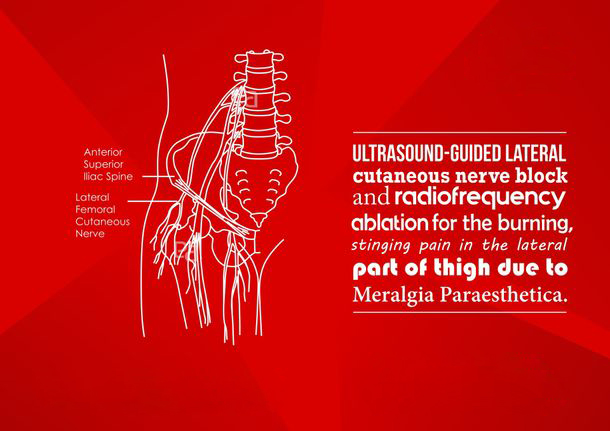

Treatments
HIP, KNEE & ANKLE PAIN

Lateral Femoral Cutaneous Nerve Block
What is a lateral femoral cutaneous nerve block?
The lateral femoral cutaneous nerve is a tiny nerve that provides sensation to the outer side of the thigh. When there is pressure, injury or entrapment of the nerve, burning pain, numbness and tingling can be felt on the front or outside of the thighs. The area that is painful may also be very sensitive to touch.
A lateral femoral cutaneous nerve block is an injection of local anaesthetic close to the nerve, which is done under ultrasound-guidance to ensure accuracy. Generally, relief may be obtained within a few days. If you get good, lasting benefit from the injection, the block may be repeated if and when the pain comes back. In some cases, one injection is all you will need. Once you get relief, self-care and prevention are encouraged. This may be done by avoiding pressure in your groin area, choosing loose-fitting clothing, or wearing an abdominal binder to support your abdomen. In addition, if you are overweight, you should try to lose weight.
What happens during the procedure?
At Atlas Pain Care, Coimbatore, you will be asked to change into a hospital gown and taken to our procedure room. Your groin area will be cleaned with antiseptic solution and draped. After identifying the nerve using ultrasound, local anaesthetic is injected. The procedure will last approximately 10 minutes. Post procedure you will have numbness over the front or outer parts of the thigh and it will take 4-6 hours to wear off.
Pulsed-radiofrequency lesioning of the cutaneous nerve of thigh
When the response to the block is good, but only lasts for a brief period, pulsed-radiofrequency lesioning of the lateral cutaneous nerve of thigh is offered. In this, the radiofrequency electric needle is introduced under ultrasound-guidance and is placed close to the nerve. The proximity to the nerve is then confirmed by passing tiny electric currents. Pulsed-radiofrequency is then performed. It is a daycare procedure that takes 30-45 minutes to perform. You will be discharged home on the same day.
What are the risks associated with this procedure?
This procedure is safe. However, with any procedure, there are risks, side effects and possibility of complications. The most common side effect is temporary pain at the injection site. Fortunately, serious side effects and complications are uncommon.
Please read our FAQ section to know more about the do's and don'ts prior to and after the procedure.

